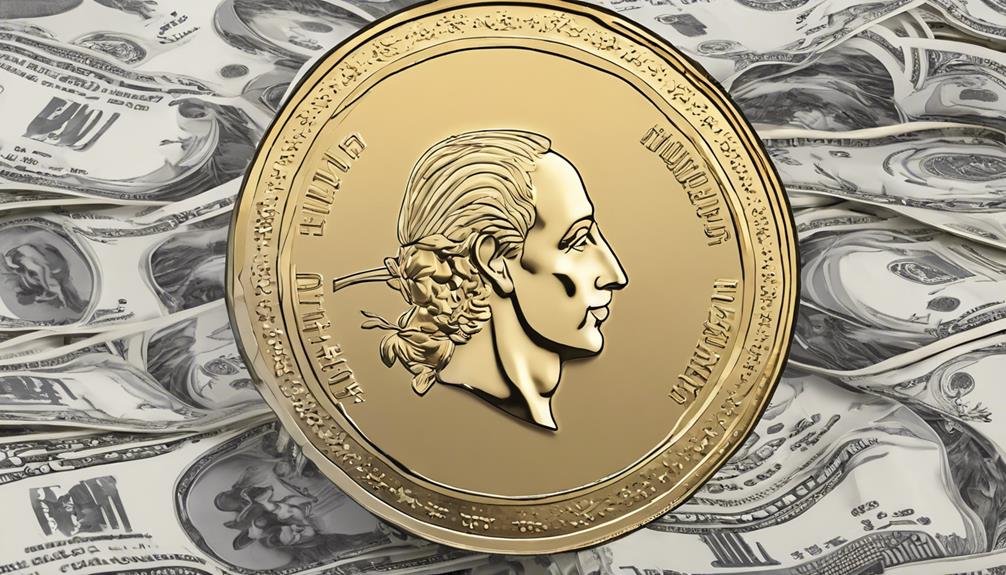Stablecoins stay valued by pegging to fiat, like Tether and USD Coin, maintaining a 1:1 ratio. They uphold this through reserves and regular audits, confirming transparency. Physical reserves tie stablecoins to real assets, offering secure backing. Audits guarantee the reserves match the circulating supply, boosting confidence. Algorithmic stability adjusts coin supply through smart contracts, responding to market demand for price maintenance.
Commodity reserves provide steady value, enhancing trust and security. Hybrid collateral models mix assets, reducing volatility impact. Understanding these mechanisms is essential for grasping stablecoin valuation intricacies.
Table of Contents
Brief Overview of Mechanisms Behind Stablecoin Value Consistency
- Pegging to fiat currencies maintains stablecoin value at a 1:1 ratio, bolstered by reserves and regular audits.
- Physical reserves backing stablecoins provide a secure link to assets, ensuring transparency and confidence.
- Algorithmic stability adjusts coin supply based on market demand, maintaining stable prices efficiently.
- Commodity-backed stablecoins offer steady value maintenance, enhancing investor confidence and credibility.
- Hybrid collateral models combine assets for diversification, establishing a resilient foundation for stablecoin value.
Pegging to Fiat Currencies
By pegging stablecoins to fiat currencies like the US dollar, their value remains stable at 1:1, ensuring users’ reliability. Tether (USDT) and USD Coin (USDC) are stablecoins pegged to fiat currencies. Tether, the largest stablecoin by market capitalization, is backed by reserves, making it a popular choice for many in the cryptocurrency market. USD Coin, fully backed by US dollars, offers stability due to its direct link to the fiat currency.
These stablecoins provide a digital representation of traditional money, giving users the benefits of cryptocurrencies without the volatility often associated with them. Regular reserves audits are conducted to verify the peg to fiat currencies, ensuring transparency and trust within the market. By maintaining this peg, stablecoins offer a reliable and secure option for those looking to engage in transactions using a stable digital asset tied to familiar fiat currencies like the US dollar.
Backing With Physical Reserves

When stablecoins are backed by physical reserves, such as fiat currency or commodities, they establish a secure link to the underlying asset. This reserve collateralization model offers transparency and confidence to token holders, as they can redeem their tokens for the actual assets. The assurance provided by physical reserves plays an essential role in maintaining stability and trust in stablecoins, influencing investors’ decisions and transactions.
Asset-Backed Stability
Asset-backed stability in stablecoins, achieved through backing with physical reserves, guarantees users a secure and reliable value proposition. These reserves can include fiat currency, commodities, or precious metals. Central entities conduct regular audits to verify the reserves match the circulating stablecoin supply, maintaining transparency. Users are subjected to Know Your Customer (KYC) procedures to comply with regulations and prevent illicit activities.
In cases of necessity, funds backing stablecoins may be frozen to safeguard stability. This model offers a trustworthy foundation for stablecoins, reinforcing confidence in their value. By upholding compliance standards and embracing transparency, asset-backed stability strengthens the credibility and sustainability of stablecoins in the digital financial landscape.
Reserve Collateralization Model
Ensuring stability through the Reserve Collateralization Model involves backing stablecoins with physical reserves like fiat currency or commodities to maintain a 1:1 peg with the underlying asset. Issuers hold reserves equal to the circulating stablecoins, ensuring price stability. These reserves are audited regularly by independent custodians to guarantee transparency and compliance. Users can redeem one stablecoin for one unit of the reserve asset at any time, providing a significant value guarantee.
The reserve collateralization model is essential in maintaining stablecoins’ consistent valuation and trustworthiness in the cryptocurrency market. By adhering to this model, stablecoin issuers can instill confidence in users and uphold the peg with the underlying asset, contributing to market stability.
Utilizing Algorithmic Stability

Algorithmic stablecoins like Basis and Terra adjust their coin supply through smart contracts, responding to market forces. These mechanisms are essential for maintaining the stablecoin’s peg and ensuring price stability. They endeavor to keep the value steady even in turbulent times by automatically minting or burning coins.
Algorithmic Price Mechanisms
Utilizing algorithmic stability, algorithmic stablecoins adjust their coin supply automatically based on market demand to maintain a stable price. These stablecoins rely on algorithmic mechanisms to control the minting and burning of coins, ensuring the price remains pegged to a specific value. The dynamic supply of algorithmic stablecoins expands or contracts in response to market conditions, stabilizing the coin’s value.
By implementing these automated processes, algorithmic stablecoins lessen the necessity for traditional collateral reserves to uphold price stability. This approach enables these stablecoins to achieve value stability by directly responding to market demand, offering a more efficient and flexible method for maintaining a stable price compared to other stabilization techniques.
Market Demand Signals
By responding dynamically to market demand signals, stablecoins utilizing algorithmic stability effectively adjust their coin supply to maintain price stability. Market demand signals serve as the crucial force behind the automatic minting or burning of coins by algorithmic stablecoins, ensuring the stability of their peg. These stablecoins adjust supply in real-time based on market conditions, allowing them to hold their valued position consistently.
Market demand signals enable algorithmic stablecoins to respond swiftly to changing market demands, thereby supporting peg stability. Through this mechanism, stablecoins can uphold their valuation by dynamically modifying their coin supply and aligning it with the prevailing market demand to sustain price stability efficiently.
Reserve Collateral Management
Maintaining a reserve of assets equivalent to circulating stablecoins is crucial to ensure stability in stablecoin projects. Reserve collateral management and algorithmic stability mechanisms play a vital role in upholding the peg and fostering trust in stablecoin projects. By efficiently managing collateral reserves, stablecoin projects can stabilize prices and offer users liquidity.
Algorithmic stability mechanisms dynamically adjust the token supply based on market demand, consistently maintaining the stablecoin value. This strategy prevents peg deviations and contributes to the continuous valuation of stablecoins. As such, a well-structured reserve collateral management system is essential for stablecoin projects’ overall success and reliability, ensuring they remain valued and trusted in the market.
Support From Fiat Backing

Supported by reserves of fiat currencies like the US dollar, stablecoins such as Tether (USDT) maintain consistent valuation in the cryptocurrency market. This backing guarantees that for each Tether issued, an equivalent amount of dollars is held in reserve, establishing a 1:1 peg. The trust among users is reinforced by the assurance that they can always redeem one USDT for one dollar, providing value stability.
Fiat backing secures the value of stablecoins and enhances their utility as a medium of exchange within the cryptocurrency market. This support from fiat reserves further facilitates stablecoins’ liquidity and widespread acceptance. Investors find comfort in these digital assets being backed by tangible fiat currencies, making stablecoins an attractive option for various trading platforms and exchanges. This backing mechanism plays a pivotal role in maintaining the reliability and consistency of stablecoin valuation in the dynamic world of cryptocurrencies.
Leveraging Commodity Reserves

Leveraging commodity reserves, stablecoins backed by assets like gold or precious metals provide a secure foundation for their value and stability in the cryptocurrency market. These stablecoins offer intrinsic value and stability, ensuring transparency and trust through their link to physical assets. Here’s why commodity reserves are important for stablecoins:
- Enhancing Stability: Commodity-backed stablecoins are less prone to wild fluctuations, maintaining a steady value due to the backing of physical assets.
- Boosting Investor Confidence: Reserves of commodities held by stablecoin issuers instill trust in investors, assuring them of the stability and reliability of the digital asset.
- Ensuring Security: Using commodity reserves adds an extra layer of security, making stablecoins more resilient to market volatility.
- Building Credibility: Stablecoins backed by commodities establish credibility and trust within the crypto ecosystem by tying their value to tangible assets.
Implementing Hybrid Collateral Models

Hybrid collateral models revolutionize stablecoin stability by combining assets like fiat currencies, cryptocurrencies, and commodities. These models enhance stability through diversification, mitigating risks linked to individual asset classes. By integrating multiple asset types, hybrid collateral models establish a robust and resilient foundation for stablecoin value, instilling confidence in users and investors.
The amalgamation of different assets in these models helps uphold the peg of stablecoins even amidst market fluctuations. This approach offers a more secure and sustainable method to maintain stablecoin value than single-collateral strategies. Through the strategic allocation of assets, hybrid collateral models provide a balanced risk exposure, reducing the impact of market volatility on stablecoin value.
Embracing hybrid collateral models represents a proactive step towards fortifying stablecoins against external pressures, ensuring a more dependable and consistent valuation over time.
Frequently Asked Questions
How Do Stablecoins Maintain Their Value?
Stablecoins rely on market demand, algorithmic mechanisms, reserve assets, market stability, issuance control, smart contracts, collateral backing, price pegging, transparency measures, and regulatory compliance to maintain their value. These factors collectively support their consistent valuation.
How Are Stablecoins Kept Stable?
Market dynamics, reserve management, and price pegging are vital to keep stablecoins stable. Algorithmic stability adjusts the token supply for equilibrium. Liquidity pools, collateral assets, and governance mechanisms guarantee stability. Decentralized control and market interventions also play key roles.
How Does USDC Maintain Its Value?
To maintain its value, USDC aligns with market demand, upholding regulatory compliance, solid asset backing, and a trustworthy issuer reputation. Coupled with high liquidity, solid reserves, and a reliable redemption process, USDC guarantees market stability.
How Do Stablecoins Maintain Their Value by Controlling the Available Circulating Supply?
Stablecoins adjust circulation based on demand and market conditions to maintain their value by controlling supply. Algorithmic mechanisms, collateral options, and reserve management guarantee stability. Asset backing, governance policies, and economic factors influence their value consistency.
Conclusion
Stablecoins maintain value through various mechanisms, such as pegging to fiat currencies, backing with physical reserves, and utilizing algorithmic stability. One example is Tether (USDT), which is backed by a reserve of USD to maintain a 1:1 peg. By employing these strategies, stablecoins provide stability and reliability in the volatile cryptocurrency market, making them a popular choice for investors and traders looking to minimize risks and preserve capital.




